The Moon goes round the Earth, about once every twenty eight days. The diameter of the Sun is about four hundred times that of the Moon, but it is also about four hundred times further from the Earth, so seen from the Earth the Sun and Moon are almost exactly the same size.
Sam’s friends find this surprising when he tells them: when they see the Full Moon when it is low in the sky it looks much bigger than the Sun when it is high in the sky, but Sam explains that this is an optical illusion: our brain sometimes makes our eyes play tricks on us when it cannot decide how far away something is.Lots of artists have painted pictures making use of optical illusions, and you can see some lovely ones by doing a web search on optical illusions in art - but take an adult with you.
The Moon rises and sets because the Earth is rotating on its axis, exactly the same as for the Sun, and exactly like the Sun it rises in the East, reaches its greatest height in the sky when it is due South and sets in the West. This is more fully explained on the Sun Page.Looking down on the Solar System from a point above the North Pole, the way we usually draw it, the Moon is going round the Earth anti-clockwise, and is also spinning on its axis anti-clockwise. This means that once each orbit it crosses a line between the Earth and the Sun.
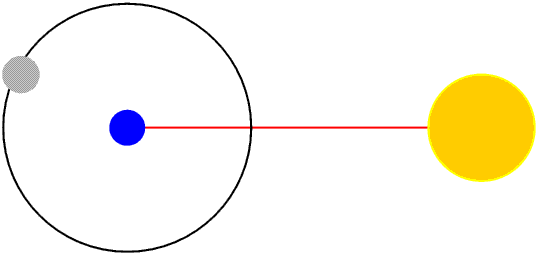
But if we look at the Solar System “edge on” we see that the Moon’s orbit round the Earth is at a slight angle to the Earth’s orbit round the Sun, so the Moon actually usually passes just over or under this line.

If the Moon is actually on this line when it passes between the Earth and the Sun we shall get a total eclipse of the Sun, but the next total eclipse of the Sun visible from where Sam lives will not happen until 21st July 2276. Eclipses are explained on their own Page. The plane of the Earth’s orbit round the Sun (that is, the sheet of paper this drawing is made on) is called the ecliptic because we can only get an eclipse when the Moon is actually on it when it crosses it, most of the time the Moon is just above or just below the ecliptic. The ecliptic and the Zodiac are explained on their own Page.
The Moon goes round the Earth about once every twenty eight days, but because during this time the Earth has moved a little round the Sun the Moon actually crosses the line between the Earth and the Sun about once every twenty nine and a half days.
The Sun, and the stars, and a candle, and a glow worm, and a electric lamp, are luminous - they give out light. But the Moon, and the planets, and your school, and almost everything you see around you, are not luminous: you can see them only because they are reflecting some of the light that is falling on them. We see the Moon and the planets only because they reflect the light of the Sun. You can also see the International Space Station in this way, from the sunlight reflected off its solar panels (the size of football pitches), but it moves across the sky very quickly so you do need to know when and where to look: Sam has an App on his tablet which tells him when he can see it from the Lighthouse.

Only the side of the Moon facing the Sun gets any sunlight to reflect, so we can only see the part of the Moon which is facing both the Sun and the Earth.This means that what we see and when we see it is changing all the time as the Moon goes round the Earth. If the part of the Moon we can see is getting bigger day by day and night by night it is waxing, and if it is getting smaller it is waning. The age of the Moon is the number of days since the New Moon. There are nine different phases.
Crescent Moons reflect very little light and are close to the Sun in the sky so we cannot always see them or do not always notice them unless we are actually looking for them and know when and where to do so.
The first time anyone can actually see the New Moon, as a very tiny crescent, is therefore just after the first Sunset after the astronomical New Moon.
This is what I and everyone else except astronomers call the New Moon - young Star Gazers find looking for it really exciting, but sadly most older astronomers take no interest in it.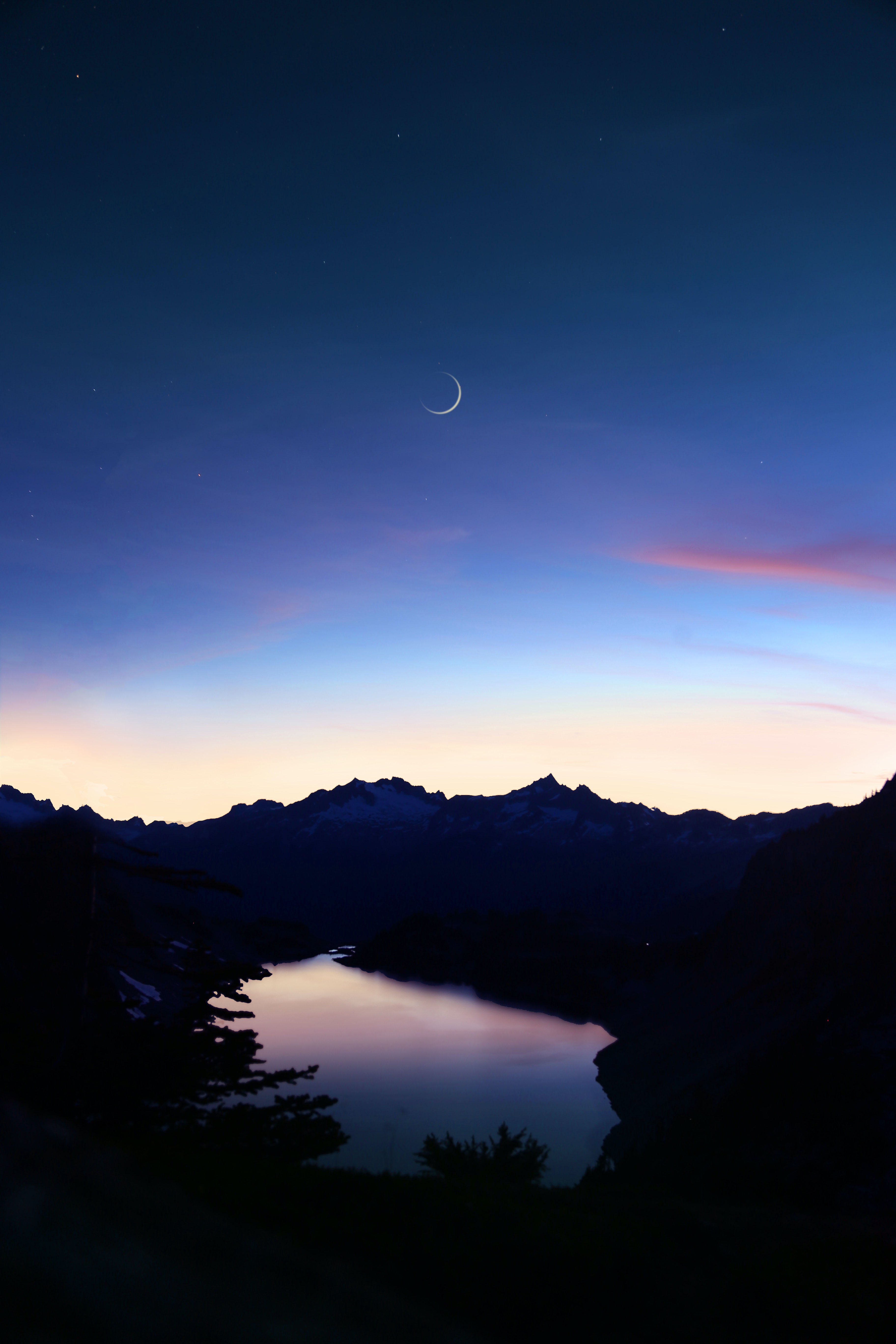
Originally the only month was a lunar month, but today most people use calendar months which are 28 or 29 or 30 or 31 days long and start in the middle of the night and have nothing to do with the Moon, but some religions such as Islam and Judaism still use a separate religious calendar based upon the New Moon and lunar months, each month starting with the first sighting of the New Moon - a lunar month of 29 days is (usually) followed by one of 30 days, and visa versa.
Four days after the New Moon the Moon has moved further round the Earth so that more of it is facing both the Earth.
In all the animations following, remember that the Sun and Moon each rise in the East, reach their highest point in the sky when they are due South and set in the West. Just note, for example, where the Sun is when the Moon is at its highest point in the sky, or where the Moon is when the Sun is setting, or where the Moon is when you cannot see the Sun.
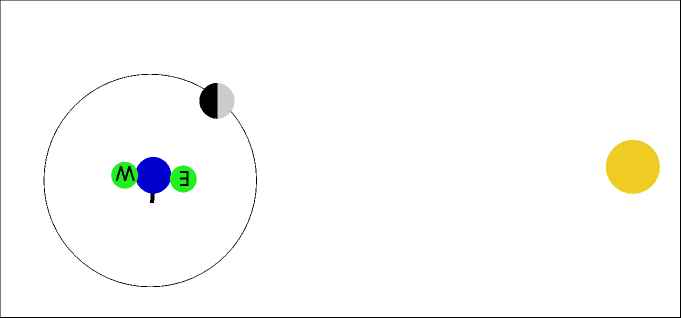
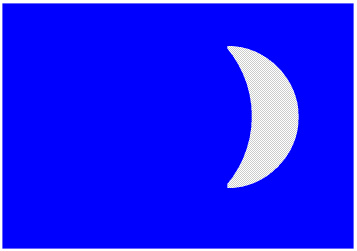
Three days later the Moon has moved further round the Earth.
The Moon will rise at midday, reach its highest point in the sky at Sunset, and set at midnight.

This is the First Quarter. It is seven days old.
The Moon moves a little further round the Earth, allowing a little more of its face to be seen.
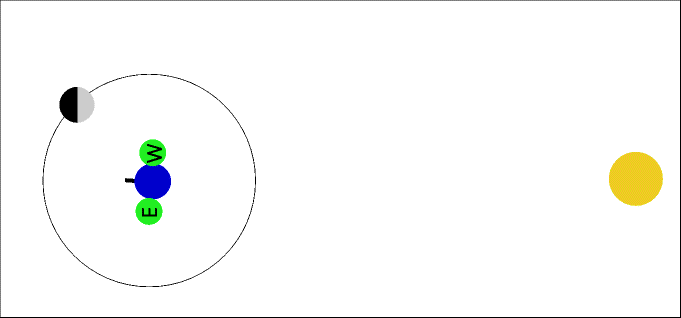
This is a waxing gibbous moon, and is about ten days old. The Moon rises in the middle of the afternoon, reaches its highest point in the sky about three hours after Sunset and sets about three hours before Sunrise.
The Moon has moved a little more round the Earth.
The Moon rises at Sunset, reaches its highest point in the sky at midnight and sets at Sunrise.
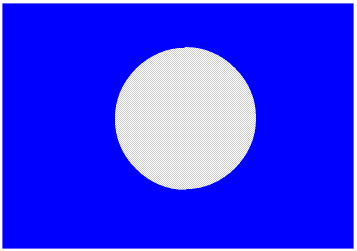
This is a Full Moon, it is fourteen days old.
The Moon moves a little further round the Earth.
It rises at about three hours after Sunset, reaches its highest point in the sky about three hours before Sunrise and sets in the middle of the morning.
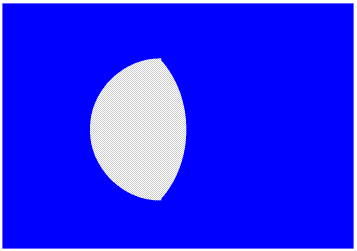
This is a waning gibbous moon, it is about 17 days old.
The Moon has moved a little further round the Earth.
The Moon will rise at midnight, reach its highest point in the sky at Sunrise and set at midday.
This is the Last Quarter. It is about 21 days old.
The Moon moves a little further round the Earth.
The Moon rises about three hours before Sunrise, reaches its highest point in the sky in the middle of the morning and sets in the middle of the afternoon.
This is a waning crescent. It is about 24 days old.
The Moon moves a little further round the Earth until it is very nearly on the line between the Earth and the Sun.
The Moon will rise just before Sunrise so we shall see it as a tiny waning crescent very low in the Eastern sky. Once the Sun has risen we shall not be able to see it.
At the time of a total eclipse the Moon exactly covers the Sun. The Moon is moving round the Earth and the Earth is moving round the Sun and spinning on its axis, so the time of totality is only a few minutes. In the same way, a few minutes after the people on one side of the Earth have watched the Old Moon disappearing into the Sun the people on the other side of the Earth will see the New Moon emerging from the Sun.
Today most people, other than sailors, who are out of doors before Sunrise have better things to do than watch the Sun rise so have never seen, or at any rate noticed, an Old Moon.

Sam has never been to the Moon and never wants to go - he does not want to be an astronaut, not even an astronomer or teacher, he wants to work out of doors, on a Nature Reserve or in a National Park. But he has lots of photographs of the Earth taken by astronauts who have been to the Moon, and from the International Space Station and other spacecraft.
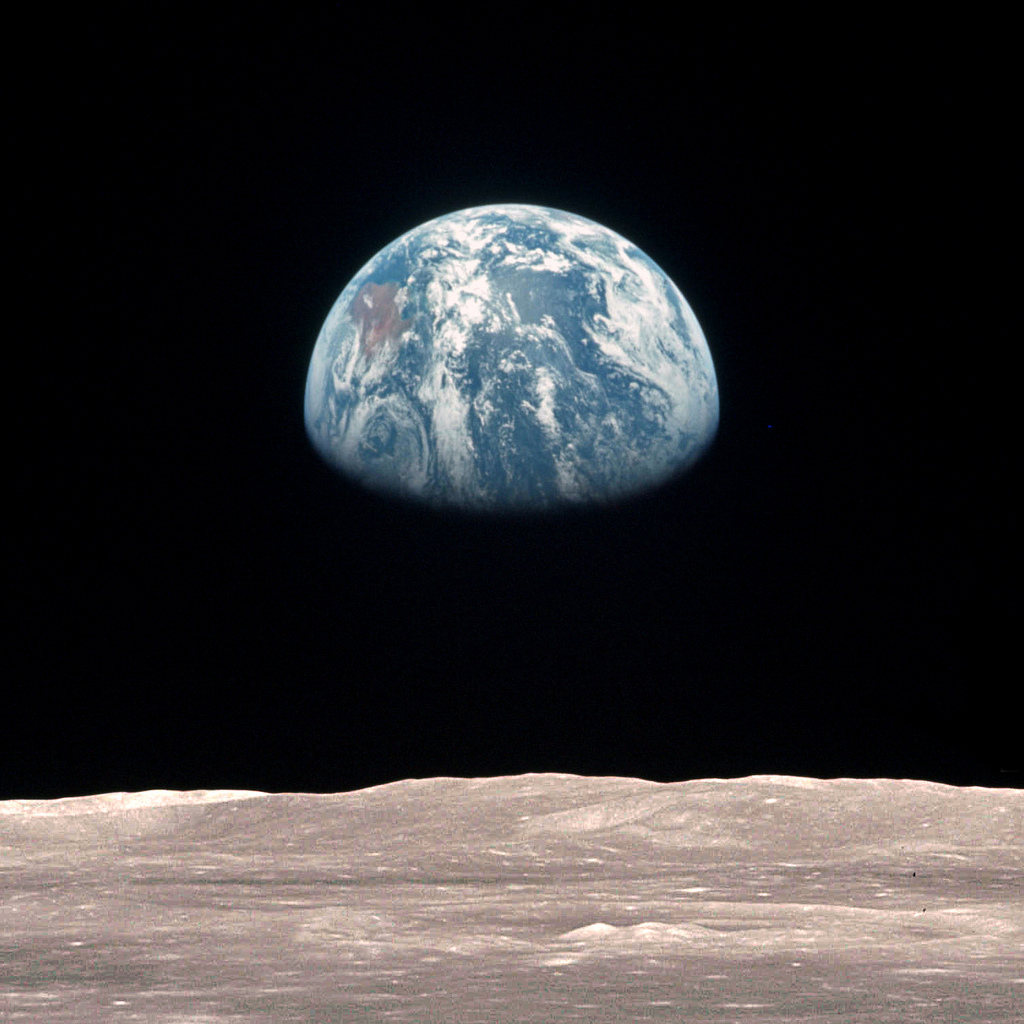
The Moon has no atmosphere to scatter the light from the Sun so the sky is black even when it is daytime. This is explained more fully here.
In the same way that Earthlings can only see that part of the Moon which is facing both the Earth and the Sun, Moonlings can only see that part of the Earth which is facing both the Moon and the Sun.
We call the planet on which we live (the) Earth because that is the only part of it that we can live on, but Moonlings and Martians and other aliens would probably call it Ocean, and in the same way that we refer to Mars as The Red Planet they would refer to Ocean as The Blue Planet. Most people who have seen the Earth from space think it is by far the most beautiful object in the Solar System.
Here are some more photographs, but showing the Earth and the Moon at the same time. The first was taken from a spacecraft and the second from the surface of Mars (but sadly by a robot made by an Earthling not by a Martian).
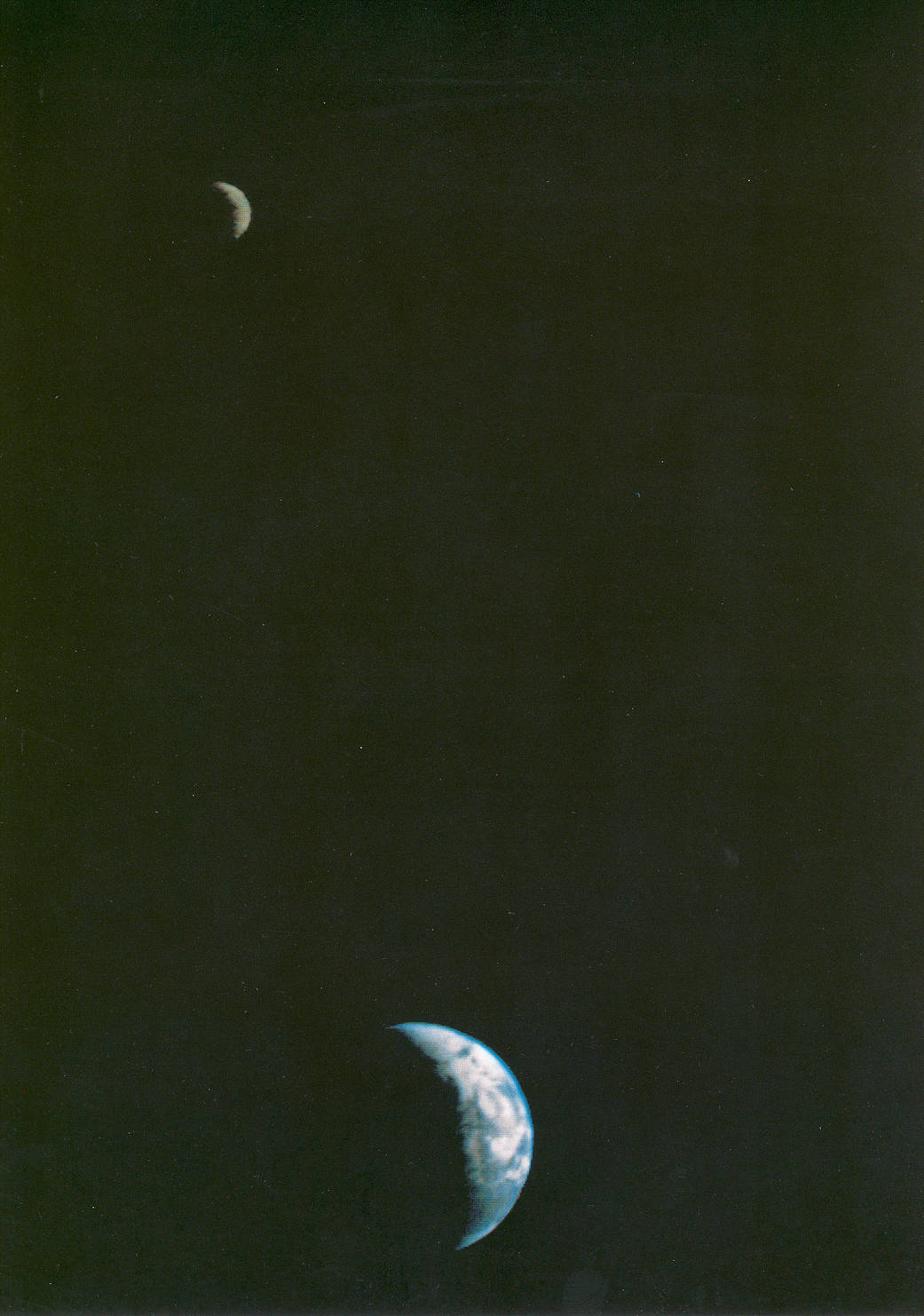

The Moon is rotating on its axis anticlockwise, just like the Earth. But it is rotating on its axis at exactly the same rate as it is going round the Earth, so the same side always faces the Earth - the “Man In The Moon” looks exactly the same to Earthlings today as it did to them when they first started drawing pictures of it, thousands of years ago. So seen from the Moon the Earth never rises or sets, it is always in exactly the same place in the sky, where depends upon your position on the Moon - Moonlings on the far side of the Moon never see the Earth at all. This is the same as satellite tv: tv satellites are about 36 000 km up in the sky above the Equator and are going round the Earth at exactly the same speed as the Earth so once your dish has been set up for the right satellite it always points to it. But the tv satellite over Africa which gives people in Europe (and of course Africa) their tv cannot be used by people in America or Australia.
But the Earth does change its shape: when Earthlings see a New Moon Moonlings see a Full Earth, and when Earthlings see a waxing crescent Moon Moonlings see a waning gibbous Earth.
The Sun rises and sets on the Moon because the Moon is rotating on its axis, exactly the same as for the Earth. But the time taken for the Moon to rotate on its axis is the same as the time taken for the Moon to go round the Earth, so the length of a “solar day” on the Moon is the same as the length of a “lunar month” on the Earth.

One evening during the October half term some of Sam’s friends are having a sleepover at the Lighthouse. It is a really clear night and just after sunset they go onto the roof to look at the sky. The Moon is a tiny crescent in the West. Suddenly Victoria shouts “I can see the whole of the Moon!” They all look, and sure enough they can all see the whole of the Moon, as a very dim disc beside the bright crescent. The Ancient Astronomers called it The New Moon cradled in the arms of the Old.
Sam says “It’s Earthshine. You can sometimes see the Moon lit up by Earthshine just after a New Moon, but only on a very clear night.” He had not intended to use his telescope that night but he takes the covers off and sets it up and they look at the “dark” side of the Moon through it. Sam explains that the Earth and the Moon both reflect the light of the Sun, and in the same way that the light reflected off the Moon can shine on the Earth so the light reflected off the Earth can shine on the Moon.
Here is a picture of when the Moon is full. The light reflected off the Moon shines on the Earth, although only when the Moon is nearly full is it really bright.
Here is a picture when the Moon is new.
Moonlings will of course have a lovely Full Earth to give them lots of light at night, what Earthlings see is the light reflected off the Earth falling on the Moon and being reflected back to the Earth! We cannot of course actually see the Moon at this time, while the Sun is in the sky, we can only see it just before Sunrise or just after Sunset.
They all go indoors and Sam gets out his globe.
He explains that different surfaces reflect different amounts of the Sun’s light. Snow and clouds reflect lots of light, seas and oceans a little less, and land and rocky surfaces much less. The planet Venus is the brightest object in the sky, after the Sun and Moon of course, not only because it is the closest planet to the Earth but also because its surface is covered with clouds (of sulfuric acid!) which reflect almost all the Sun’s light. Sam holds the globe so that everyone is facing the side with Britain on it, and they can see that most of this side of the globe is Africa, which reflects very little sunlight, so people in Britain see only a tiny amount of Earthshine on the Moon, and then only on a very clear night, so most people never notice it, whereas just after sunset in the United States (where this photo was taken) it is being reflected off the Pacific Ocean.
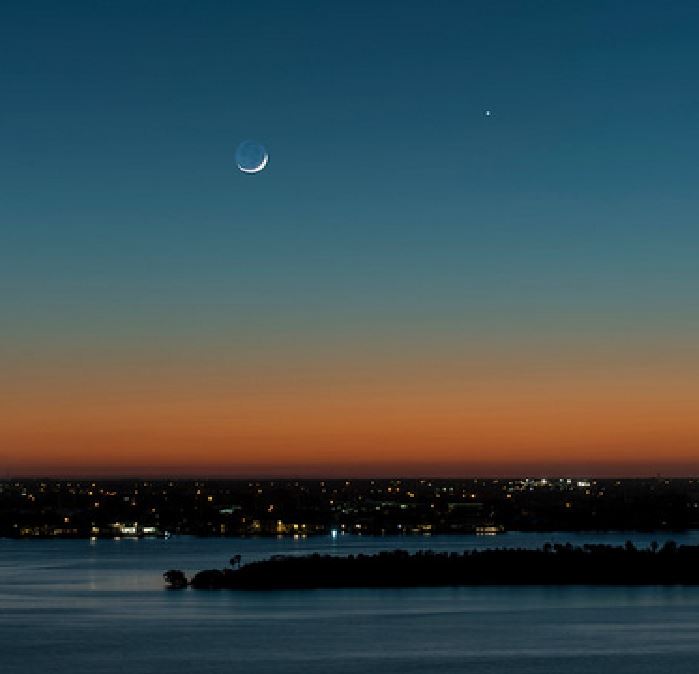
The very bright “star” in the photo is of course the planet Venus. Venus, the “Evening Star” is described on a later Page.

© Barry Gray August 2023